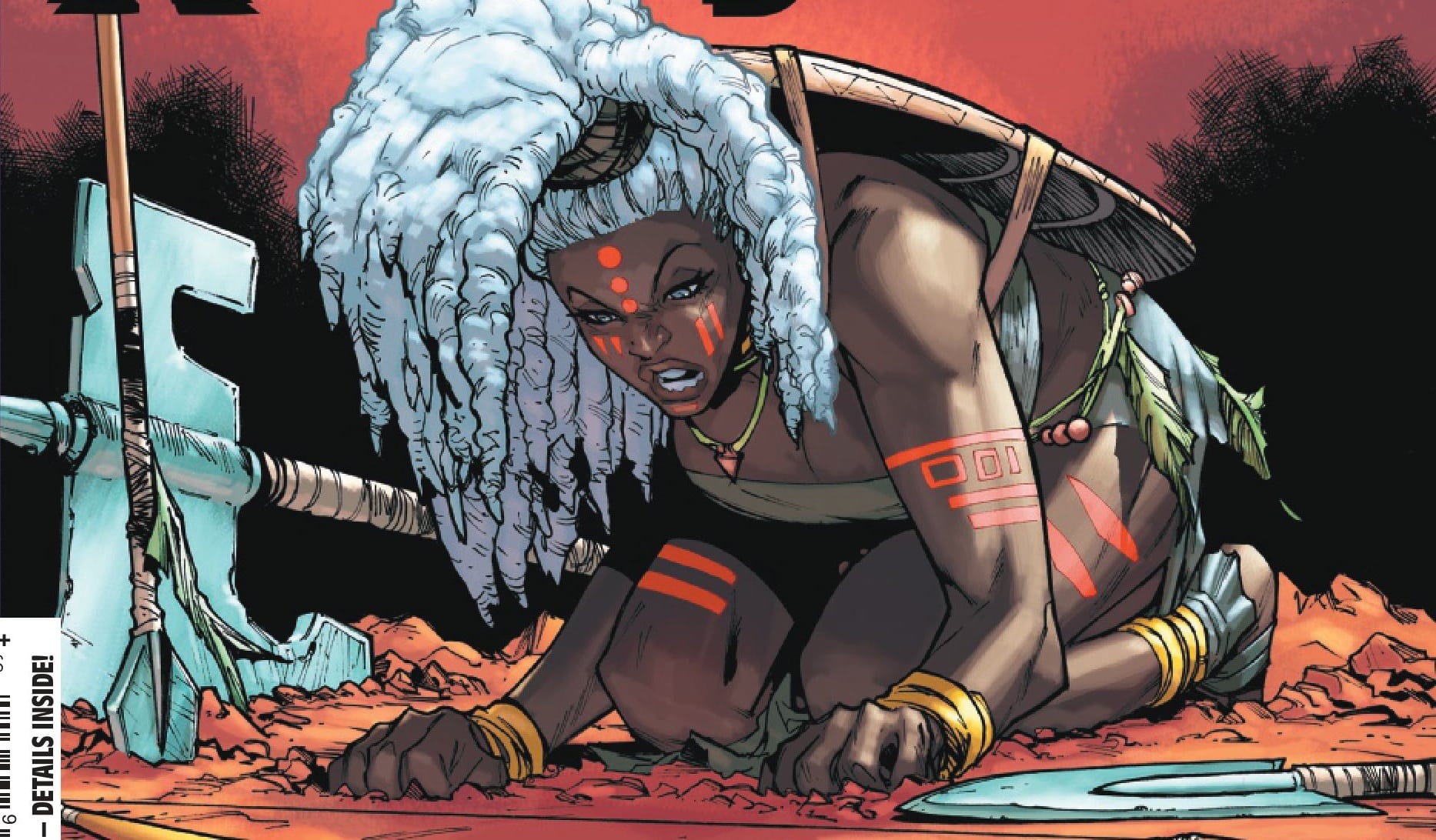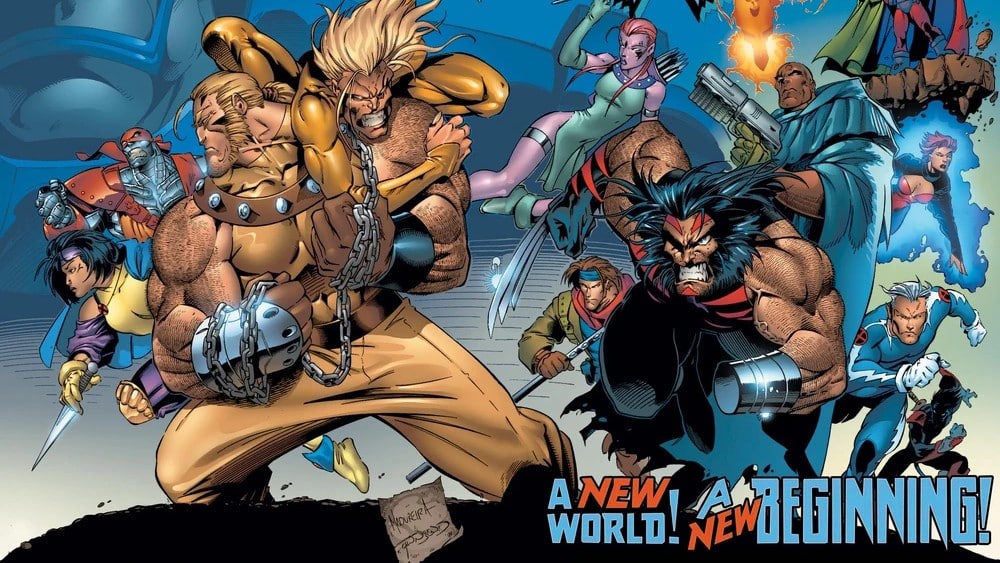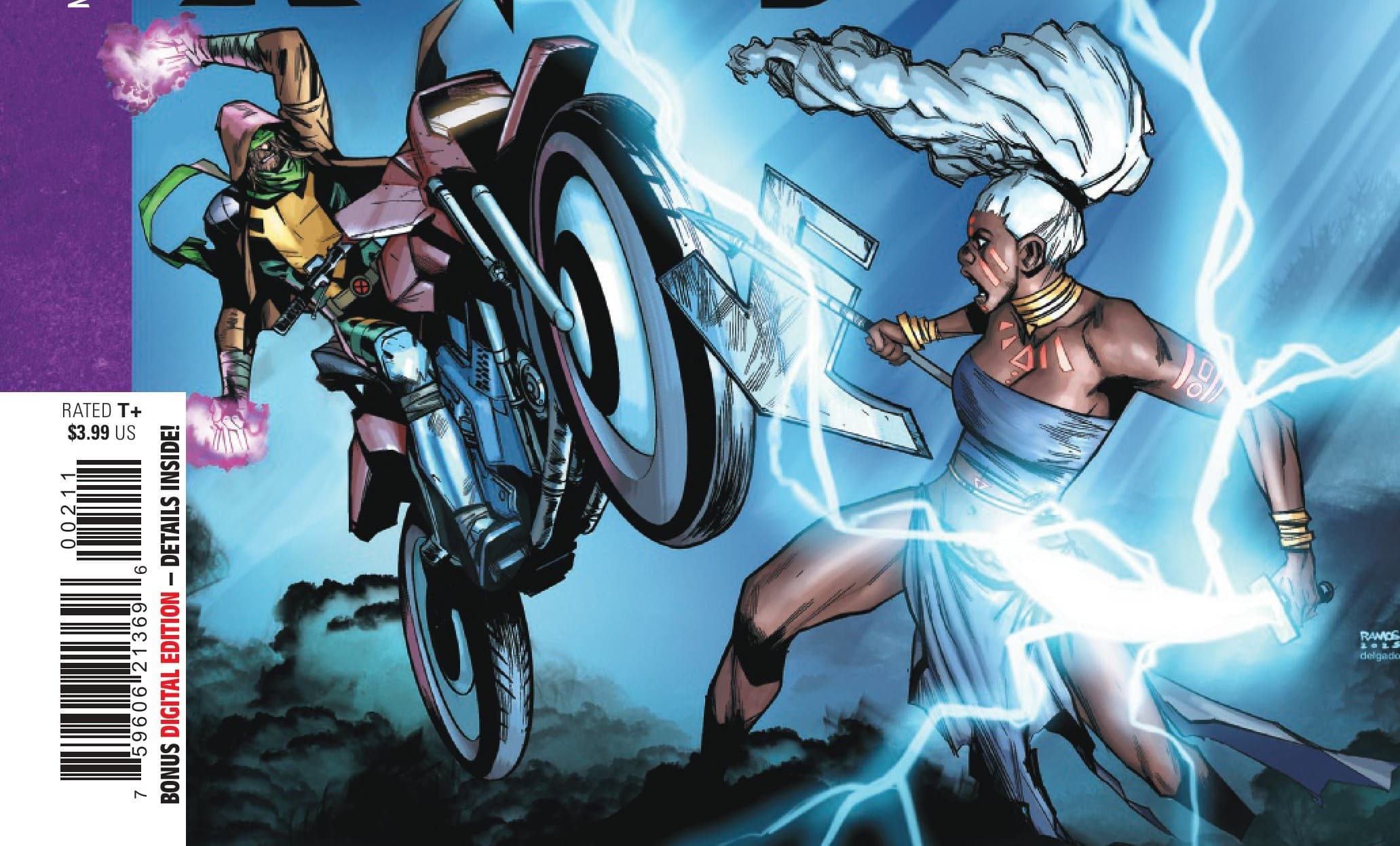The end of the Krakoan age continues! Ten years in the future, man and machine are on the verge of total victory, but mutants aren’t going down without a fight, while an enigmatic new player emerges in Rise of the Powers of X #1, written by Kieron Gillen, drawn by R.B. Silva, colored by David Curiel and lettered by Clayton Cowles.
Austin Gorton: Welcome to what I’ve been told is the RoPoX Tox Box, our place for discussion of Rise of the Powers of X, the sister series to Fall of the House of X, the dual concluding narratives of the Krakoan age. While I don’t want to spend a ton of time comparing the two series, right off the bat, it’s remarkable how much better this series is at invoking the energy of its predecessor (the original Powers of X): We’ve got time jumps and character redesigns and future twists on old favorites and R.B. Silva drawing it all.
Rasmus Skov Lykke: It very much feels like the “proper” end to the Krakoan age, as set out by Jonathan Hickman et al, while Fall of the House of X is more the end of the Krakoan age as it eventually played out by … well, mostly by Gerry Duggan and co. And while Duggan’s X-Men has been perfectly fine superhero comics, HoX/PoX was something more. It’s a joy to see some of that wild spark brought back here.
Austin: This is going to sound more denigrating than I intend it to be, but the two series (at least in these inaugural issues) are playing to their writers’ strengths: Duggan has spent the last couple of years doing pretty straightforward, crowd-pleasing superheroics against the Krakoan backdrop, and that’s what FoHoX is, with its rescue missions and talk of fastballs special. Meanwhile, in Immortal X-Men, Gillen has been probing deeper into the Krakoan status quo and revealing more about the overarching threat of Dominion, all of which comes into play here. I know which I prefer, but I also don’t want to say one is inherently better than the other; they just seem to be doing different things.
The Computer Wore Menace Shoes

Austin: We begin as the issue does 10 years in the future, with Nimrod and Omega Sentinel on the verge of not just total Orchis victory, but total machine victory. Mutants are all but extinct, and Dominion looms far earlier than ever before, thanks to Omega Sentinel’s knowledge of the future. Things are bleak: Emma is dead (and broken) amid the rubble of SWORD. Nimrod is likening it to The Terminator with a happy ending.
Rasmus: I’ll admit that I’m not old enough to have read the original Nimrod stories, so I’ve only heard about him secondhand. But this cheerful, whimsical robot we’re presented with here (and in much of his past appearances in the Krakoan age) is strange to me. I always assumed that he was this dark, serious, stern, cold and — for lack of a better word — mechanical entity. So every time he does something like talk about The Terminator, make dumb jokes or — strangest of all — sing, it brings me right out of the story. I don’t know, am I in the wrong here, Austin?
Austin: Yes and no. The Nimrod of the Krakoan age is, for the most part, a unique entity, at least in terms of his characterization and his pleasant, almost childlike nature juxtaposed against his murderous desires. That said, if we’re being generous, there is some slight connection to the original Nimrod stories of the ’80s, in which Nimrod spent his time after coming to the present masquerading as a kindly dockhand and living with the family of Jaime Rodriguez. At one point, Claremont intended to develop Nimrod into a full-fledged vigilante folk hero before rolling him into his ultimately scuttled plans for Jim Jaspers and the FuryItKillsSuperheroes (what was to be the original Mutant Massacre), and there are some hints of that in the stories we did get.
All of which is to say, there is some precedent for a Nimrod who acts somewhat more human than we’d expect of a mutant killing Super Sentinel, even as this particular iteration of the character is fairly unique.
Ironically, one of my favorite moments in Rise of the Powers of X #1 comes as a result of Nimrod’s relative humanity: his utter confusion at the failure to achieve Dominion (“What is happening to our God?”), possibly the closest to comeuppance we’ll get for the character.
Rasmus: Without getting into the end of the issue or possible ponderings of future issues, I suspect that we’ll see Orchis and their A.I. “colleagues” get theirs numerous times before the end of the series.
I’ll say one of my favorite moments comes at the beginning of the issue. One of the joys of any of these big, important series is finding out which characters are going to be part of it. So I always perk up when we get to the recap page and the dramatis personae. Here I was delighted to find Gambit and Mystique, eager to see what Gillen was going to do with them (especially Mystique, who has been a central figure for the entire Krakoan age).
And then Gambit shows up for all of a page and a panel before blowing himself up to buy Mystique time to possibly escape, only for Mystique to also die on the same page. (Though not before an incredibly rare tender moment from her, as she assures Remy that he was a good son-in-law, despite it all.)
It’s a great way for Gillen to establish the stakes and that we’re really dealing with the end times here. No one is safe. Everyone is going to die. And this is just the first issue.
Austin: Perhaps nothing suggests we’re in truly dark times more than Mystique expressing naked sentiment to Gambit. There are some other fun future variations on display here — the kind of thing Powers of X did as well, which eventually gave us Rasputin IV — Kate bulked up by a Death Seed, Kamala as Captain Krakoa, an Iron Man who is … robot Tony Stark. And Wolverine is there, because he’s always there (another Powers of X tradition). As dark as things are when Gambit and Mystique sacrifice themselves, we get a brief “snatching victory from the jaws of defeat” moment as these X-Men, under the guidance of a Professor X-ified Synch, launch their plan to defeat Orchis’ world engine and stop Dominion. And then succeed, mostly, except for the fact that their victory is achieved by that Dominion that’s been lurking throughout much of the twilight of the Krakoan age, the OG Sinister, Enigma.
Mister Reese

Austin: Enigma is, of course, the recently revealed “real” Mister Sinister, an A.I. consciousness of the original Nathanial Essex who sent four aspects of himself out into the world in the form of the Mister Sinister we all know, Doctor Stasis, Mother Righteous and Orbis Stellaris, all designed to help Essex/Enigma achieve Dominion. Before he enters the fray here, we see that the X-Men aren’t the only ones opposing Nimrod and Omega Sentinel: One of those Engima facets, Doctor Stasis, is making his own move on Dominion, just like Sinister (in “Sins of Sinister”) and Mother Righteous (in recent issues of Immortal X-Men).
Rasmus: I love how both here and in Sins of Sinister, Sinister, Stasis, Stellaris and Righteous are each other’s worst enemies. They’re the ones foiling each other’s plans, constantly fighting to be the first — the only one — to achieve their dreams and become a Dominion. And it’s all pointless, because they’re all just puppets doing the work of the real Essex.
Even if you’re the most dastardly, evil, Machiavellian mastermind in X-Men history, there’s still someone behind you, pulling your strings.
And what wonderful irony, that the way Essex achieves this is by splitting himself up, giving each aspect of himself its own body and mind, while Sinister is (in)famous for taking aspects of people and fusing them together in a single body and mind.
Austin: Ah, I love that! It’s like Sinister has been subconsciously trying to reassemble himself into the whole through his work with chimeras.
We mentioned R.B. Silva up top, but there’s a page in the sequence involving Stasis’ plot to achieve Dominion (with the help of Cadena and the Children of the Vault’s vault) that I want to call out, in which Stasis and Cadena put their plan into motion and Silva renders it via a series of nontraditional geometric panels, reflecting the actions of the characters and the beats of the plot in the layout and shape of the panels, as Statis (hexagon) and Cadena (circle) enter the Vault, which is depicted as a series of hexagon panels followed by one with a circle inside of it, before that gives way to the circular vault door with Dominion inside it. Just a fantastic bit of design work amid all the usually enjoyable action storytelling and sweeping cosmic vistas.
Rasmus: As we discussed in the intro, much of this issue’s success is because it plays to Gillen’s strengths as a writer. But none of that would work if Silva didn’t absolutely nail every moment that’s called for. Everything from the grand cosmic vistas to the good old ultraviolence to the small moments between characters to the new designs debuting in this issue. It all just works, largely because Silva makes it work.
And he’s helped by David Curiel on colors, who manages to keep the tone perfect between nightmarish, end-of-the-world future and big, splashy superheroics. Everything feels grand, bathed in lush hues, even as the world comes tumbling down. And then Curiel drops it all, giving us a dim, shadowy page, as Logan finds Mister Sinister beaten and bloody in a cell. This isn’t a big superhero moment. This is just a sad man, confronted with what his works have wrought.
And then he’s killed, triggering his final failsafe.
There’s No Place Like No Place

Austin: At which point it’s revealed that everything we’ve been reading is the “alternate” timeline in which Doctor Stasis almost achieved Dominion (i.e. his version of “Sins of Sinister”), as referenced most recently in Immortal X-Men #18. How did this twist work for you?
Rasmus: Surprisingly well, I’d say.
I didn’t expect it to come so soon. I thought we’d spend more time with these future X-Men, as they all seemed so interesting. But when A.I.ron Man died as soon as he entered the fray, I realized that things were going to go even worse than expected.
Which should’ve been obvious in retrospect. Powers of X did much the same thing, with all the various timelines eventually not having a direct relation to the current story, and more serving as a warning for the challenges that the mutants face. So it makes sense that Gillen would do much the same thing here, showing how hopeless the situation Xavier, Cypher and Rasputin IV are in is.
And what a treat it was seeing Cypher again. He’d been conspicuously absent from the X-books for the past while (especially the end of Immortal X-Men), so it was nice seeing where he’d been and getting a hint at what they’ve been working on.
Austin: The twist worked for me as well. It is, in its way, as much the kind of callback our colleagues (rightly) criticized Fall of the House of X #1 for deploying too much (given that Powers of X also features a reveal that what we’ve been reading wasn’t the future of the “main” timeline but an ultimately trimmed branch of Moira’s timeline). But unlike Powers of X, it smartly gets that reveal out of the way earlier in the series, requiring it to hoist less narrative weight the second time around, and uses it not just to say, “remember this thing from this other story you liked?” but also to drive the narrative forward, by reminding us of the stakes and revealing at least part of the series’ actual core cast.
We’re in agreement on Cypher as well — his absence from Fall of X has been felt, especially given the memorable way he was taken off the board by Krakoa itself just before the fall. His presence here is presumably the start of that payoff, and it’s already clear he’s been as affected by recent circumstances as everyone else.
Rasmus: Yeah, things are looking dire. We already knew this from the entire Fall of X sequence of books, and this issue really drives it home. The mutants are up against the wall, desperate for survival. Not only for them, but for everyone. Luckily Xavier has a plan: They just have to kill a preteen girl.
As if that alone wasn’t unlikely enough to happen in a Marvel comic, killing Moira would also mean that “Krakoa will never have been and will never be,” per Xavier’s closing line in the issue. This is clearly never going to happen, because Marvel isn’t in the business of resetting their timelines.
Austin: There is absolutely no way in heaven or hell this story is going to conclude with the X-Men assassinating pre-mutant Moira and wiping all of the Krakoan age from history, for a whole slew of reasons, ranging from the reasons you mentioned to the way stories are constructed: Very rarely does it work that the thing the story says is going to happen in Chapter 1 actually happens, without any complication or variation, by the end. This is less the declaration of the plot of the story as it is a tease, a cliffhanger, a lead-in to the next chapter, a marker of just how desperate things are for the heroes that such a course of action is being considered, and in those terms, it does its job.
Yet part of me also hates that it’s even there, for all the eyerollingly-bad headlines and takes we’re going to see about how Marvel is wiping out four years of X-Men continuity as a result.
Rasmus: Yeah, basic media literacy is all that’s required to know this isn’t going to happen. But you’re exactly right. There will be a flood of awful attention grabbing articles about this. More than any actual reaction to the work, I suspect this is why Kieron Gillen posted on Bluesky on Tuesday that he was going to go mostly offline for now. It is in many ways the sensible thing to do.
Well, except just reading the series and not jumping to (stupid) conclusions. I, for one, am excited to see how this impossible situation will be worked out!
Inside the RoPoX Tox Box
- Wolverine gets chucked into the Worldmind by the souped up Shadowtiger via a fastball special, saying Pete would have loved it, a fast callback to last week’s fastball special discussion between Wolverine and Colossus in Fall of the House of X #1.
- The “Battlefield of the Rise of the Powers of X” data/timeline page does an astonishingly good job of laying out all the various timelines, alt realities and methods for creating/ending them in play.
- It also clarifies something that either wasn’t clear or we completely missed in our review of Immortal X-Men #18, that the Enigma Dominion didn’t just scuttle the attempts (by already existing) of the other Sinisters to achieve their own Dominion, but was created as a result/thanks to the contributions of all those efforts (which then meant it already existed, because it exists outside time and space and my head hurts).
- Unclear at this point if the identity of/details surrounding the trickster Dominion that sent Omega Sentinel back in time is important/relevant, or just one of those cool throwaway ideas left there for future exploration if someone wants.
- Xavier attributes Doug’s snippiness to his rapport with Krakoa and Krakoa’s own suffering state, but some in the CXF Slack suggested it’s possible Doug is picking up on the vibes of Sinister and/or Sabretooth, who’ve also spent significant time in the pit.
- Guesses on the redacted members of the No Place team? Throw ’em at us on the socials!
Buy Rise of the Powers of X #1 here. (Disclaimer: As an Amazon Associate, ComicsXF may earn from qualifying purchases.)







